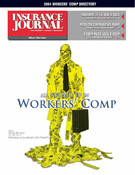Applicant attorneys, labor and industrial physicians are attempting to divert attention from the real cost drivers in California’s workers’ compensation system. Despite overwhelming evidence from the Insurance Commissioner, the Commission on Health, Safety and Workers’ Compensation, the Los Angeles Grand Jury and the Workers’ Compensation Research Institute that cost drivers in California’s workers’ compensation system are out of control compared to other major industrial states, the California Applicant Attorney’s Association and its allies contend that regulating the insurance industry will solve the problem. The AFL-CIO 2004 legislative agenda proposes that workers’ compensation rate regulation be reinstituted and that limits be placed on fees paid to insurance broker-agents.
Broker-agent fees and commissions are optional, negotiable and competitive. As such they cannot be compared to costs for medical treatment, physical therapy and penalties that employers are forced to pay.
Employers have the option to use the services of agents and brokers to shop and place workers’ compensation insurance or they can purchase coverage from one of the insurers that accept business directly.
Insurers set the commission rate it pays the broker-agents. Broker-agents negotiate fees with the employer directly.
Competition forces the thousands of broker-agents in the state to compete for the employer’s business by offering the best services at the lowest price.
Insurance broker-agents do much more than place coverage with an insurer. For example, employers also rely on their broker-agents to provide services including:
• Risk assessment and analysis
• Risk control
• Risk management
• Claims management
• Loss prevention and loss control
• Safety services
These services result in savings, not additional costs to the workers’ compensation system. If caps on commissions and fees were to cause broker-agents to stop providing these services, the costs of the system overall would rise, not fall.
If commissions were capped, the broker-agent would unbundle these services from the commissionable functions of shopping and placing insurance. Employers would incur the same or high costs through negotiated fees. If broker-agent fees were capped, the broker-agent would be placed at a competitive disadvantage with other professionals who provide these services, such as third party administrators, claim managers, return to work professionals and safety consultants. Caps instituted across the board on all of those who provide these services would be unenforceable.
The percentage of workers’ compensation payments attributed to broker-agent commissions and fees has been grossly misstated in pie charts circulated in the Capitol the past several months. California Workers’ Compensation Institute (CWCI) published a pie chart in July of 2003 that erred in showing “Agent & Broker Fees” as comprising 11.9 percent of payments in 2002. CWCI mistakenly lumped insurer “Other Acquisition Expenses” into the “Agent & Broker Fees” category. The error was corrected and another pie chart was issued that correctly reported that “Agent & Broker Fees” represented only 5.8 percent of costs incurred in 2002.
More recent data will show that broker-agent commissions and fees fell drastically in 2003 and 2004. According to the Insurance Commissioner, the State Compensation Insurance Fund, which writes over 60 percent of the insured employers, reduced its commissions by 45 percent, to a scale with a maximum of 5.5 percent that drops to 0 percent for more than 90 employer classifications with the highest premiums. Private insurers are similarly driving commission rates down to an average of between 3 percent to 5 percent.
In summary, the services that the broker-agent performs save money in the system. The compensation that the broker-agent receives for these services is market driven. Employers benefit from the high level of competition among broker-agents and because commissions and fees change as market conditions change. In a recent report comparing California’s workers’ compensation costs to twelve other industrial states, Workers’ Compensation Research Institute reported that California had more cost drivers than any of the other states studied. Nowhere in that report did it list or suggest that broker-agent fees as one of those cost drivers. Let’s get our eye back on the ball and deal with the real cost drivers.
Andrew Valdivia is executive vice president and principal at White & Co. Insurance Inc. in Santa Monica. White is also president of the Insurance Agents and Brokers of the West.
Was this article valuable?
Here are more articles you may enjoy.


 Florida Public Adjuster, Renter Charged With Filing Claim on Rental Home
Florida Public Adjuster, Renter Charged With Filing Claim on Rental Home  USAA to Lay Off 220 Employees
USAA to Lay Off 220 Employees  Harvard Study Again Stirs the Pot on Demotech Ratings of Florida Carriers
Harvard Study Again Stirs the Pot on Demotech Ratings of Florida Carriers  California Sees Two More Property Insurers Withdraw From Market
California Sees Two More Property Insurers Withdraw From Market 


